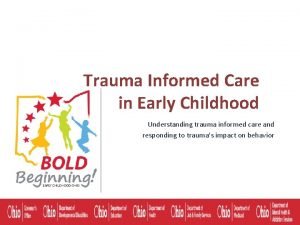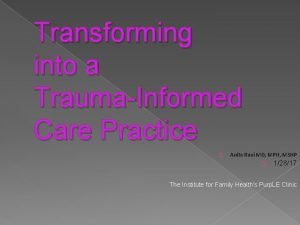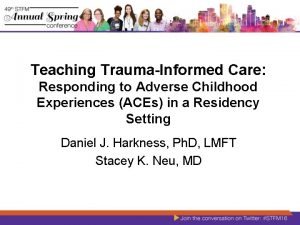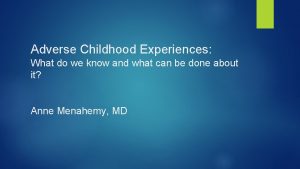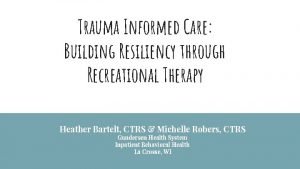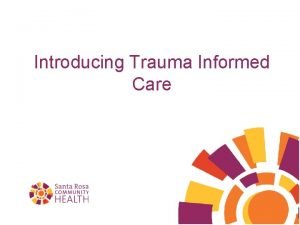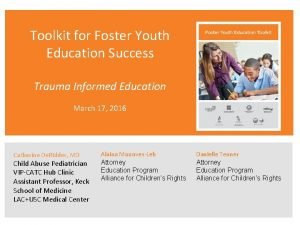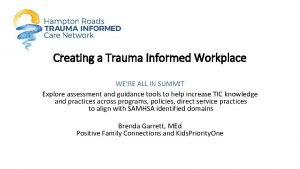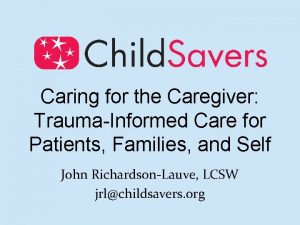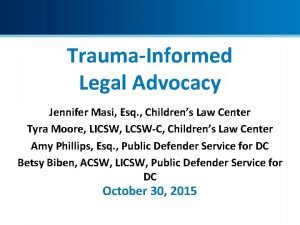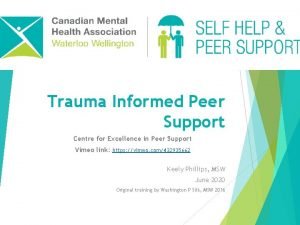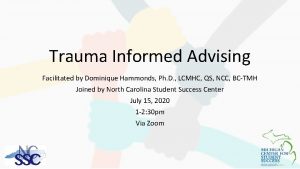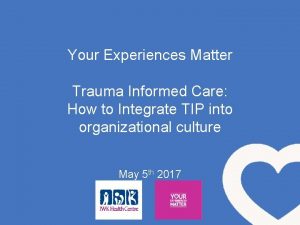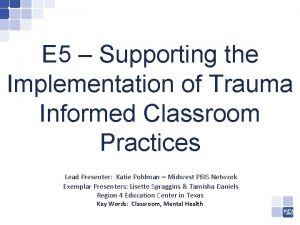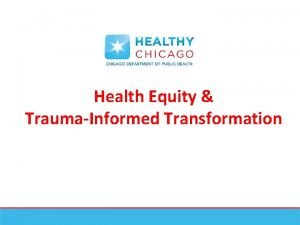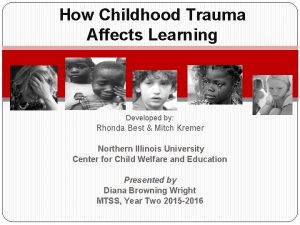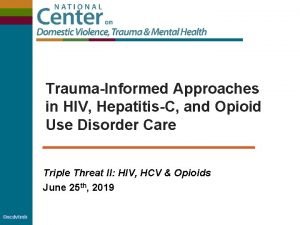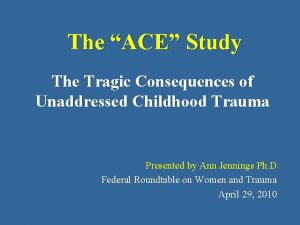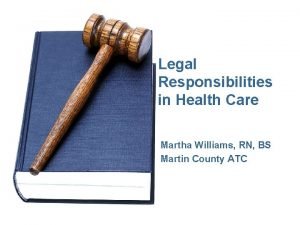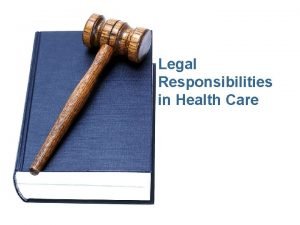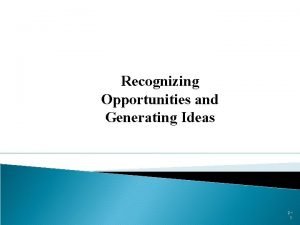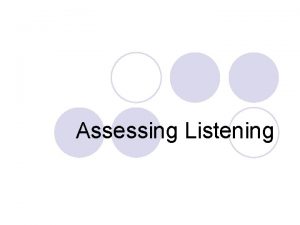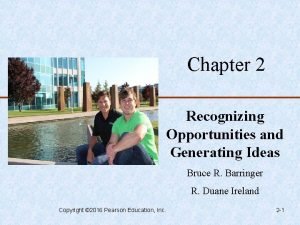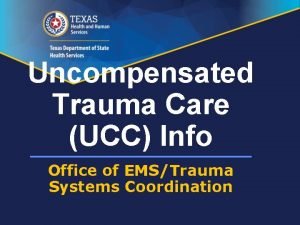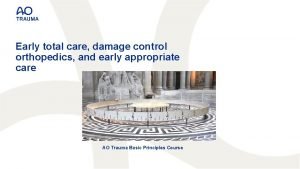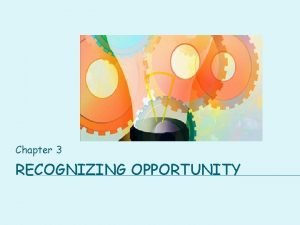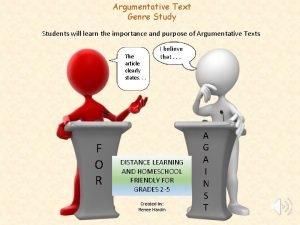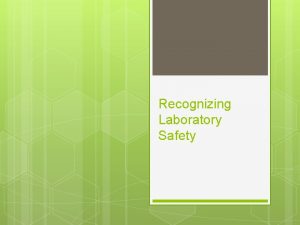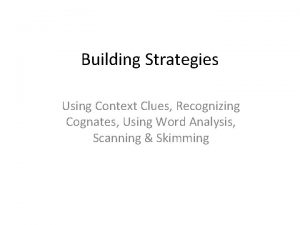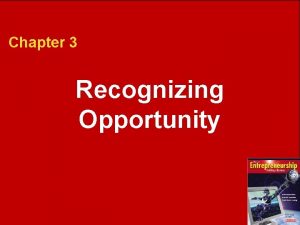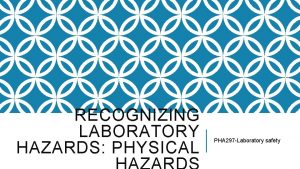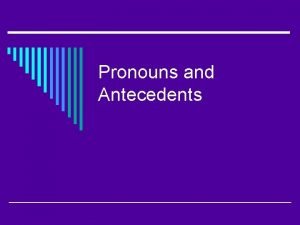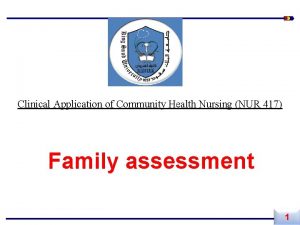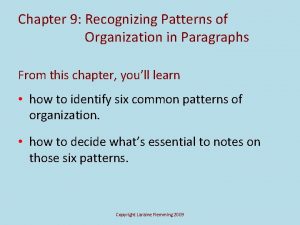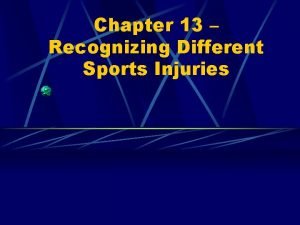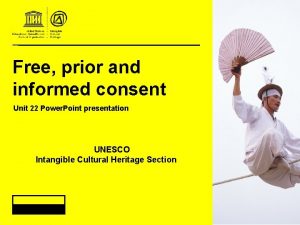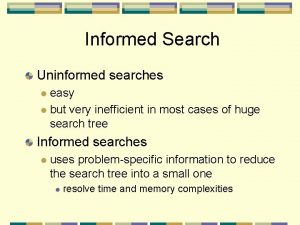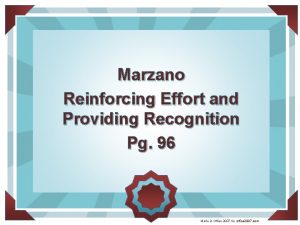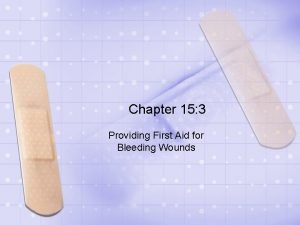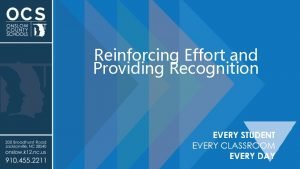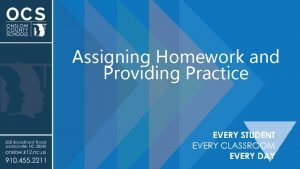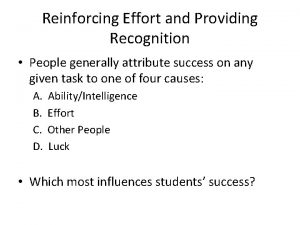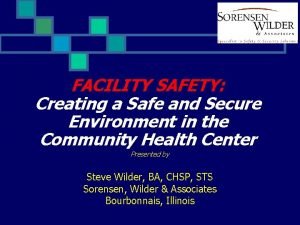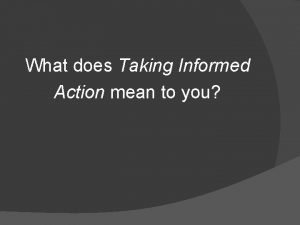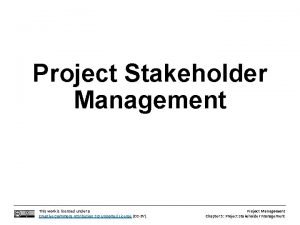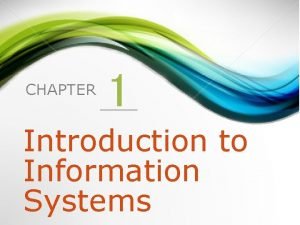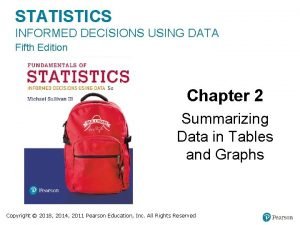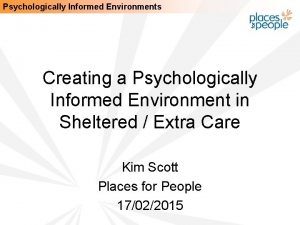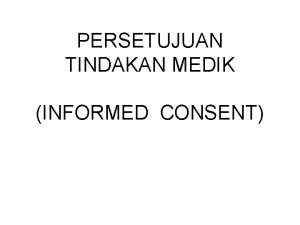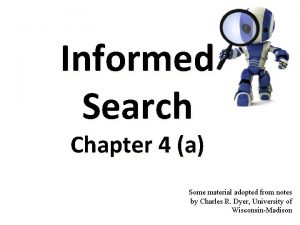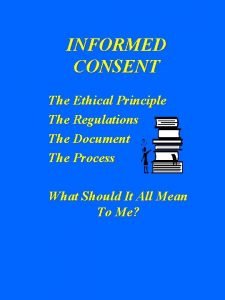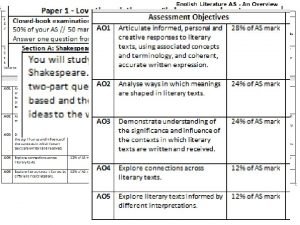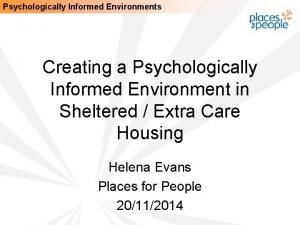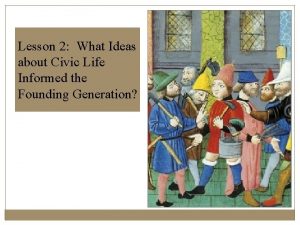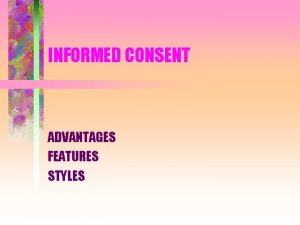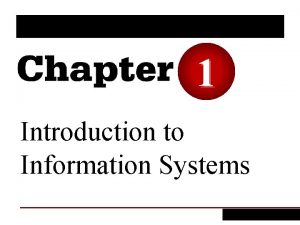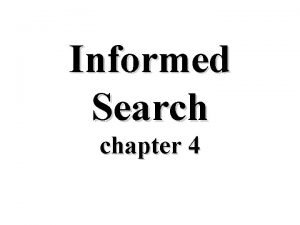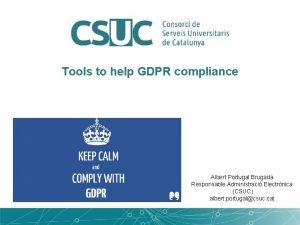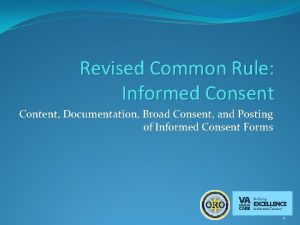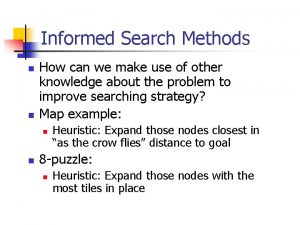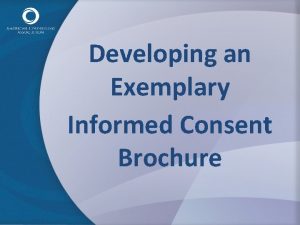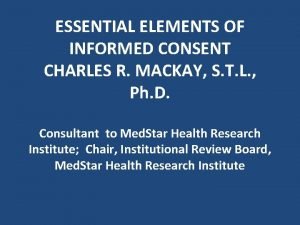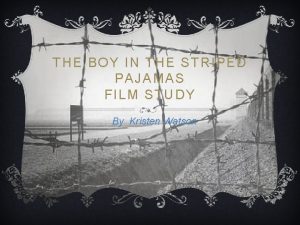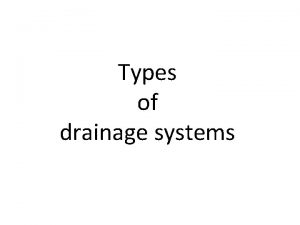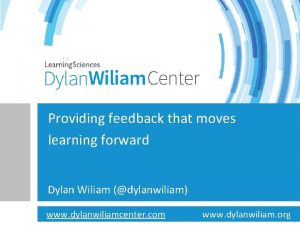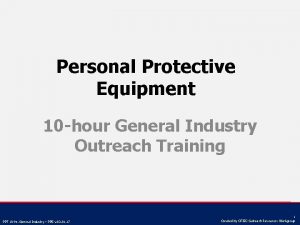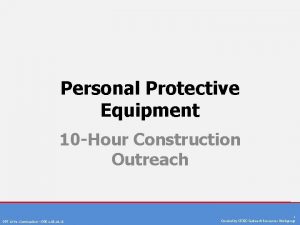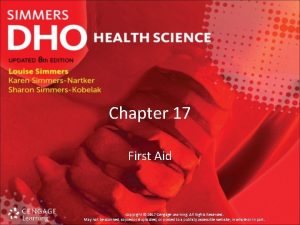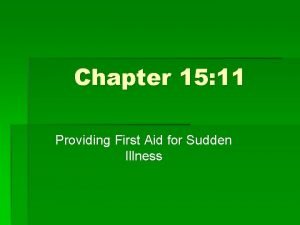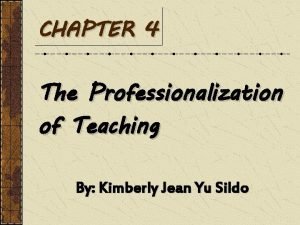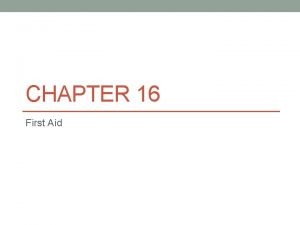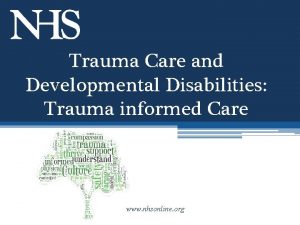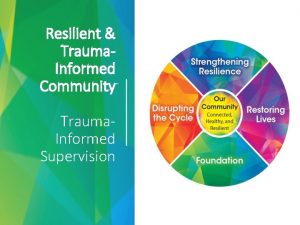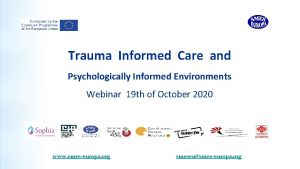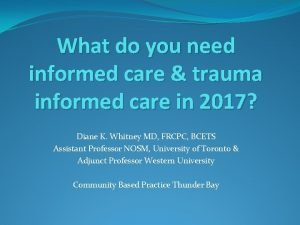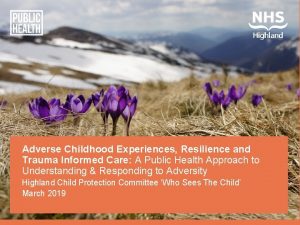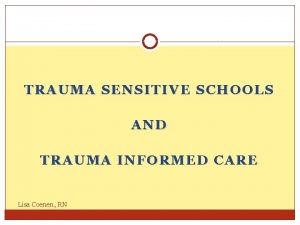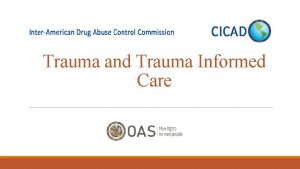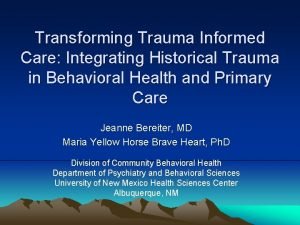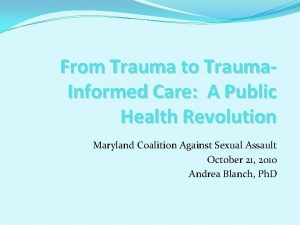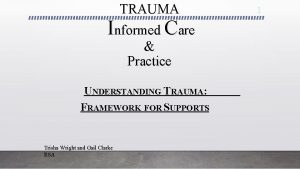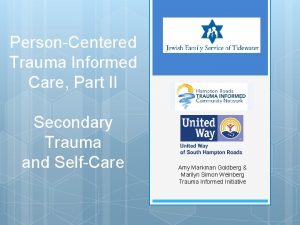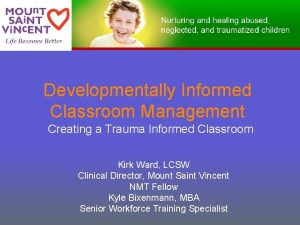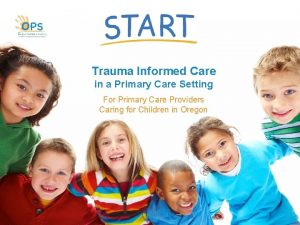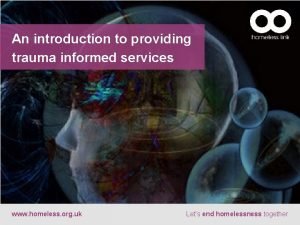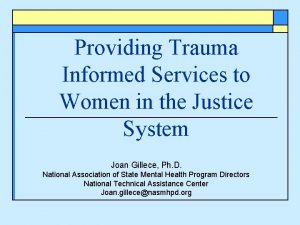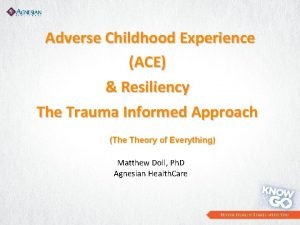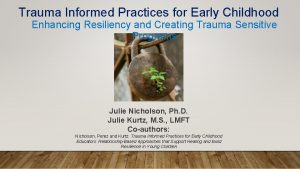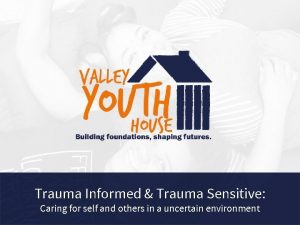RECOGNIZING CHILDHOOD TRAUMA AND PROVIDING TRAUMA INFORMED CARE

















































































































- Slides: 113

RECOGNIZING CHILDHOOD TRAUMA, AND PROVIDING TRAUMA INFORMED CARE FDR Middle School Bristol, Bucks County GORDON R. HODAS M. D. August 23, 2007

INTRODUCTION IMPORTANT STARTING POINTS l Schools repeatedly identified as a core protective factor for children and adolescents: – If child attends regularly, feels safe, is engaged. – If educational program is individualized, flexible, and committed to wellbeing of students. l Most effective way to achieve above = “trauma informed care. ”

INTRODUCTION TRAUMA INFORMED CARE l Ultimately, TIC is an attitude & set of beliefs: l The youth’s development & choices have been limited by traumatic life experiences. l Youth’s negative behaviors largely an outcome of trauma & not intentional. l Given the opportunity & support, the youth can and will do better. l TIC not stand alone: “value added” to effective treatment, care, and education.

INTRODUCTION THE CHALLENGE OF EFFECTIVE TEACHING “Being a teacher, that’s an awful hard thing to learn. . A good teacher has got to be able to know what a person can be taught…a teacher is most interested in teaching the normal way, the way the average person learns. And there’s some people, they’re lacking in knowing how to do things the average way. It don’t make no sense to them. . what counts (is) having a way that is your own…all the way to you from inside your own self. ”

INTRODUCTION THE BEST TEACHER, THE BEST METHOD “The best teacher will be he who has at his tongue’s end the explanation of what it is that is bothering the pupil. These explanations give the teacher the knowledge of the greatest possible number of methods, the ability of inventing new methods, and, above all…the conviction that the best method would be the one which would answer best all of the possible difficulties incurred by a pupil – that is, not a method but an art and talent. ” Leo Tolstoy

INTRODUCTION “REFLECTING ON TEACHING” – IMPORTANCE OF BEING “A REFLECTIVE PRACTITIONER” Reflection-in-action involves thinking about what one is doing, in order to “cope with…troublesome ‘divergent’ situations of practice, ” and come up with new ways to address the problem. “When someone reflects-in-action, he…constructs a new theory of the unique case. ” Don Schon, The Reflective Practitioner

INTRODUCTION OUR FOCUS: CHILDHOOD TRAUMA AND ITS IMPACT ON STUDENT LEARNING & BEHAVIOR l PART I: Trauma – basic considerations & role of culture l PART II: Impact and neurobiology l PART III: Direct effects of trauma on student learning and behavior l PART IV: Maintaining trauma informed care, and trauma informed educational settings

PART I: TRAUMA – BASIC CONSIDERATIONS l l l Prevalence Definition Types Determinants of child’s response Cultural considerations

PART I: TRAUMA – BASIC CONSIDERATIONS CHILDHOOD TRAUMA AS A “HIDDEN EPIDEMIC” l Actual prevalence high. l Disclosure of maltreatment to professionals uncommon. l Screening by professionals inconsistent. l Poorly understood by many. l Responses by professionals can be counterproductive and re-traumatizing. l Distinction: trauma informed care vs. trauma-specific treatment.

PART I: TRAUMA – BASIC CONSIDERATIONS CHILDHOOD TRAUMA PREVALENCE l Adolescent Inpatients: 93% with history of trauma, 32% met PTSD criteria. l Up to 67% males and females seeking substance abuse Rx have PTSD – complete or partial. l Youth in JJ: 93% of males, and 84% of females, with one or more traumatic events. l Youth in JJ: witnessing – violence or death: – 59% males. – 47% females.

PART I: TRAUMA – BASIC CONSIDERATIONS TRAUMA AS PRECURSOR TO ARREST & VIOLENCE l Arrest, as consequence of childhood abuse or neglect: – As juvenile, 53% more likely. – As young adult, 38% more likely. l Violent crime leading to arrest: 38% more likely.

PART I: TRAUMA – BASIC CONSIDERATIONS CHARACTERISTICS OF TRAUMA l Traumatic event (per DSM IV) involves experiencing, witnessing, or being confronted by event or events that involved “actual or threatened death or serious injury, or a threat to the integrity of self or others. ” l The individual’s response involved “intense fear, helplessness, or horror” (with children, may have disorganized or agitated behavior). l Only 2 trauma-related diagnoses: Acute Stress Disorder, and Posttraumatic Stress Disorder (reexperiencing, avoidance/numbering, hyperarousal).

PART I: TRAUMA – BASIC CONSIDERATIONS TYPES OF TRAUMA INCLUDE l Neglect, and abuse – physical, sexual, emotional. l Witnessing domestic abuse or community violence. l Bullying. l Traumatic loss. l Medical trauma. l Natural disasters. l War and terrorism. l Refugee trauma.

PART I: TRAUMA – BASIC CONSIDERATIONS DETERMINANTS OF CHILD’S RESPONSE TO TRAUMA – RESULT OF 3 SETS OF VARIABLES: l Characteristics of the traumatic event(s) l Characteristics of the environment l Characteristics of the individual child

PART I: TRAUMA – BASIC CONSIDERATIONS CHARACTERISTICS OF THE TRAUMATIC EVENT(S) l Frequency, severity, & duration of event(s) l Degree of physical violence and bodily violation l Level of terror and humiliation experienced l Persistence of threat l Physical and psychological proximity to event and perpetrator

PART I: TRAUMA – BASIC CONSIDERATIONS CHARACTERISTICS OF THE ENVIRONMENT l Immediate reaction of caregivers or those close to child l Type, quality of, and access to, constructive supports l Attitudes and behaviors of first responders and caregivers l Degree of safety for victim following the event l Prevailing community attitudes and values l Cultural and political considerations

PART I: TRAUMA – BASIC CONSIDERATIONS CHARACTERISTICS OF THE INDIVIDUAL CHILD l Age and stage of development l Prior trauma history l Intelligence l Strengths, coping, and resiliency skills l Vulnerabilities l Child’s culturally based understanding of the trauma

PART I: TRAUMA – CULTURAL CONSIDERATIONS SIGNIFICANCE OF CULTURE IN UNDERSTANDING IMPACT OF TRAUMA ON CHILDREN l Traumatic event – influenced by cultural beliefs and parenting practices. l Environment – may or may not recognize event as traumatic, such that trauma not acknowledged and support not offered. l Child – may or may not cognitively experience event as traumatic, but body responds anyway.

PART I: TRAUMA – CULTURAL CONSIDERATIONS THE REFUGEE EXPERIENCE: 3 PHASES (NCTSN) l Preflight – Time prior to escape from country of origin; disruption, violence, danger. l Flight – Time of transitional placement (refugee camps) following displacement from one’s home; uncertainty; basic needs unmet; possible separation of family and/or physical/sexual trauma to children. l Resettlement – Family settlement in new, host country; clash between traditional and new cultures, social disruption, and task of acculturation.

PART I: TRAUMA – CULTURAL CONSIDERATIONS TYPES OF PREFLIGHT STRESS FOR CHILDREN l Witnessing atrocities. l Possible direct victimization. l Insufficient food & other necessities. l Forced labor. l Forced combat. l Separation from family. l Segregated camps.

PART I: TRAUMA – CULTURAL CONSIDERATIONS TYPES OF FLIGHT STRESS FOR CHILDREN l Uncertainty and instability. l Basic needs unmet – malnutrition and medical care. l Separation from family and familiar cues. l Refugee camps. l Depersonalization. l Witnessing violence or suicide. l Victimization in camp.

PART I: TRAUMA – CULTURAL CONSIDERATIONS TYPES OF RESETTLEMENT STRESS FOR CHILDREN l Loss of culture and social network of homeland (“cultural bereavement”). l Reconciling traditional beliefs and practices with those of prevailing culture. l Language barriers. l Stigma based on nationality, race, religion.

PART I: TRAUMA – CULTURAL CONSIDERATIONS TYPES OF RESETTLEMENT STRESS FOR CHILDREN (2) l Victimization through bullying. l Lack of familiarity with laws & social service systems l Differential rates of acculturation between parents and child. l Possible inversion of family hierarchy. l Possible secrecy/denial re past family trauma.

PART I: TRAUMA – CULTURAL CONSIDERATIONS SYMPTOMS RESULTING FROM REFUGEE STRESS l Each phase of refugee process associated with Sxs. l Younger children more vulnerable. l Stress exposures cumulative. l Internalizing behaviors common – anxiety, PTSD, depression, withdrawal, somatic complaints. l Externalizing behaviors – impulsivity, inattention/ hyperactivity, aggression, delinquency.

PART I: TRAUMA – CULTURAL CONSIDERATIONS SOURCES OF POTENTIAL COPING & RESILIENCE l Parental wellbeing, parental support to child. l Esprit de corps among war-exposed children. l Devotion to a cause. l Abilify to recognize and avoid danger. l Abilify to appeal to adults for caretaking. l Abilify to manage anxiety and calm self.

PART I: TRAUMA – CULTURAL CONSIDERATIONS SOURCES OF COPING AND RESILIENCE (2) l Use of play. l Use of imagination – wishing things were different. l Sense of humor. l Acculturation to new country. l Use of social support network in community. l Maintaining connection to culture of origin.

PART I: TRAUMA – CULTURAL CONSIDERATIONS BACKGROUND ON LIBERIA l Located on Africa’s western coastline. l Founded as a republic in 1847 by freed American slaves. English spoken in much of Liberia. l Civil war began in 1989 and continued intermittently, disrupting prior prosperity and creating strife among indigenous groups. l Resettlement of Liberians in America began in 1992, under the U. S Refugee Program (USRP).

PART I: TRAUMA – CULTURAL CONSIDERATIONS BACKGROUND ON LIBERIA (2) l Resettlement increased in 1998 due to continued instability. l Between 2003 -2005, more than 8, 000 refugees emigrated to US. Bucks County as one site. l Most wealthy Liberians in US came earlier. l Recent & current immigrants more rural, & greater exposure to war, flight, and refugee camp life. l Some on the run for a decade or more.

PART I: TRAUMA – CULTURAL CONSIDERATIONS BACKGROUND ON LIBERIA (3) l “Dual flight” for some: forced to flee 2 x or more. l Many adults with limited exposure to formal education. Children with refugee camp education. l One parent families common, due to flight, death. l Recent settlement of extended families in US, some with limited previous time living together. l Informal guardianships common. Not all children biological.

PART I: TRAUMA – CULTURAL CONSIDERATIONS CONSEQUENCES OF PRIOR REFUGEE STATUS l Poor primary health care – concept not embedded. l High blood levels possible. l Lack of trust toward outsiders. l Education limited, disrupted in past, low skill levels. l Education may not be a parental priority for child. l Lack of understanding of expected school behavior, and limited readiness.

PART I: TRAUMA – CULTURAL CONSIDERATIONS PARENTAL RESPONSE TO PRIOR TRAUMA l Shame and humiliation. l Secrecy. l Denial. l Unwillingness to discuss. l Impact often greater on 2 nd generation, the children of parents subject to trauma in homeland.

PART I: TRAUMA – CULTURAL CONSIDERATIONS PARENTING PRACTICES l Extended family, not nuclear family, the typical family structure in earlier village life and in US. l Large, multi-generational families, many in house. l Membership in family fluid and informal. l Communal network of support helps raise children. l Any adult in network seen as empowered to monitor child and intervene.

PART I: TRAUMA – CULTURAL CONSIDERATIONS PARENTING PRACTICES (2) l Traditional values: adults primary, children respect elders. Older children help with younger siblings. l Children allowed considerable independence in play. l Corporal punishment seen as necessary to prepare child to be good citizen, and sign of good parent. l Harsh tone and verbal reprimands also common. l Ancient custom – punishing child with ground hot peppers.

PART I: TRAUMA – CULTURAL CONSIDERATIONS PARENTING – POTENTIAL CULTURAL CONFLICTS l Unapproved family member picks up child at school. l Examples of possible “neglect”: – – l Ten year old child left alone to care for infant. Child running around without apparent supervision. Examples of possible “abuse”: – – Giving child a “beating. ” Use of switch or belt, leaving a mark. Verbal abuse. Use of ground hot peppers.

PART II: TRAUMA – IMPACT AND NEUROBIOLOGY l l Impact global, encompassing development, physical health, behavior, beliefs, and values Neurobiological processes influence, and are influenced by, above elements

PART II: TRAUMA – IMPACT CHILDHOOD TRAUMA OVERVIEW l Multiple variables determine impact, as discussed. l Single events disrupt the life of child and family, but often resolve without serious long-term damage. l Severe, chronic, and/or recurring trauma can have serious, long-term consequences. l These consequences can affect every aspect of a child’s functioning, including mental & physical health, values & beliefs, learning, and behavior.

PART II: TRAUMA – IMPACT CHILDHOOD TRAUMA OVERVIEW (2) l Childhood maltreatment – neglect, physical abuse, emotional abuse, and sexual abuse – can have severe consequences. Secretive, stigmatizing, family betrayal, threats to prevent disclosure. l Refugees may have prior exposure to war, displacement & loss, trauma in refugee camp, family separation, and stress of immigration & resettlement.

PART II: TRAUMA – IMPACT CHILDHOOD TRAUMA OVERVIEW (3) l Immigrant children may be subjected to other forms of trauma in US: l Witnessing – community violence or domestic abuse l Bullying. l Victimization by other community violence (drugs, guns, etc. ). l Possible traumatic loss.

PART II: TRAUMA – IMPACT CONSEQUENCES OF SEVERE, CHRONIC TRAUMA l Neurobiological abnormalities. l Effect on brain size and activity. l Disruption of normal developmental process. l Likelihood of additional victimization. l Likelihood of aggression & violence.

PART II: TRAUMA – IMPACT SEVERE, CHRONIC TRAUMA: CONSEQUENCES (2) l Likelihood of negative lifestyle & unhealthy habits. l Physical health problems, during childhood and throughout the life cycle, and shorter life expectancy. l Increased risk of psychiatric disorders. l Increased risk of substance abuse.

PART II: TRAUMA – IMPACT SEVERE, CHRONIC TRAUMA: CONSEQUENCES (3) l Effect on behavior – What do we see? l Effect on relationships – What do we see? l Effect on beliefs – What are typical beliefs re others? l Effect on values – What are typical values? l Effect on learning and school-related behavior.

PART II: TRAUMA – IMPACT VICTIMS AND VICTIMIZERS: SAD REALITY: l Many juvenile offenders were victimized earlier. l Childhood and youth victims are, as result of their victimization, at higher risk of becoming victimizers. l Dramatic example, per Philadelphia police: 90% of city’s murderers, and also 90% of city’s homicide victims, have prison records. l Trauma increases likelihood of arrest – 53% more for juveniles, and 38% more for young adults.

PART II: TRAUMA – IMPACT TRAUMA AS PRECURSOR TO VIOLENCE l Violent crime leading to arrest: 38% more likely. l Adjudicated females (2 separate studies): – Over 75% of adjudicated females had been sexually abused. – Over 90% of incarcerated females reported some form of childhood maltreatment (2 separate studies).

PART II: TRAUMA – NEUROBIOLOGY THE BOTTOM LINE: LONG-TERM EFFECTS OF TRAUMA ON THE BRAIN l Severe, prolonged childhood abuse damages the developing brain via hormonal and structural changes. l Potentially irreversible, although the brain is dynamic and continues to grow into mid-20’s. l Childhood violence a significant causal factor in 1025% of all developmental disabilities.

PART II: TRAUMA – NEUROBIOLOGY BASIC SURVIVAL RESPONSES TO DANGER AND THREAT (NORMAL PROCESSES): l Hyperarousal responses: “fight” or “flight”, in support of active mastery and/or l Dissociation responses: passive, surrender response, to escape/avoid situation. v Both responses are normal and of adaptive benefit, increasing the likelihood of survival.

PART II: TRAUMA– NEUROBIOLOGY THE HYPERAROUSAL RESPONSE: l Either “fight” or “flight, ” enabling individual to take emergency action in response to fear, terror, and danger. l “Fight” = self-defense. l “Flight” = removing self from danger. l Mediating neurobiology: Catecholamines – adrenaline and noradrenalin – and hypothalamic pituitary axis.

PART II: TRAUMA – NEUROBIOLOGY THE HYPERAROUSAL RESPONSE (2): l Physiological responses associated with hyperarousal: a. b. c. l Increased heart rate. Increased blood pressure. Increased energy availability in skeletal muscles. Observable manifestations of hyperarousal: a. b. c. Highly focused attention Sweating Erect posture

PART II: TRAUMA – NEUROBIOLOGY THE DISSOCIATION RESPONSE l Dissociation = “disengaging from stimuli in the external world and attending to an internal world” (Perry et al, 1995), in order to “camouflage” oneself and child and buy time. l Dissociation involves emotional numbing and withdrawal. l A dissociation continuum, depending on trauma severity and circumstances. l Mediating neurobiology: Increase in vagal tone.

PART II: TRAUMA – NEUROBIOLOGY THE DISSOCIATION RESPONSE (2) l Physiological responses associated with dissociation: a. b. l Decrease in heart rate. Decrease in blood pressure. Observable manifestations of dissociation: a. b. c. d. Decreased movement Compliance Avoidance Restrictive affect

PART II: TRAUMA – NEUROBIOLOGY TRAUMA DISRUPTS AROUSAL SYSTEM l Hyperarousal the primary problem. l Catecholamine release, and over-activation of hypothalamic-pituitary axis. l A previously adaptive, emergency response becomes maladaptive. l Adaptive emergency “state” becomes maladaptive “trait. ”

PART II: TRAUMA – NEUROBIOLOGY SPECIFIC COMPONENTS OF HYPERAROUSAL l High baseline. l Low threshold for activation. l High amplitude of response. l Slow turnoff. l Higher baseline. l Future reactivation. l Result = Impaired capacity for self-regulation.

PART II: TRAUMA – NEUROBIOLOGY SPECIFIC STRUCTURAL BRAIN CHANGES, WITH SEVERE TRAUMA AND PTSD (De. Bellis): l Smaller brain volumes (decreased function): – Total intracranial volume. – Corpus callosum. l Larger volumes of ventricles – left ventricle & total lateral ventricles.

PART II: TRAUMA – NEUROBIOLOGY BRUCE PERRY’S CONCEPT OF “NEUROBIOLOGICAL REGRESSION” l Cortex essential for self-regulation – direct effect plus management of lower brain responses. l With severe trauma, the brain relies on primitive responses to danger, bypassing the cortex. l “Neurobiological regression” = retreat from the cortex to increasingly less mature levels of brain functioning (cortex to limbic system, to midbrain, to brainstem) – “the trauma response. ”

PART II: TRAUMA – NEUROBIOLOGY DIRECT IMPACT OF THE TRAUMA RESPONSE ON THE INDIVIDUAL l When cortex is bypassed, the individual cannot listen, reason, or problem-solve effectively. l When flooded by hyperarousal and catecholamines, same limitations apply. l Impact is global: internal discomfort & fear, impaired learning, problem solving, daily functioning, ability to form relationships, develop & display empathy.

PART II: TRAUMA – NEUROBIOLOGY POSSIBLE IMPACT OF STUDENT’S TRAUMA RESPONSE ON SCHOOL STAFF l Student’s trauma response misperceived by adult as a personal challenge, or as intentional defiance. l With above mindset, adult less likely to respond sympathetically to the student. l Staff anger, feeling challenged or devalued. l Counter-aggression may occur.

PART III: DIRECT EFFECTS ON STUDENT LEARNING AND BEHAVIOR l l Effects on academic performance Effects on student behavior

PART III: DIRECT EFFECTS ON STUDENT LEARNING AND BEHAVIOR HELPING TRAUMATIZED CHILDREN LEARN: SUPPORTIVE SCHOOL ENVIRONMENTS FOR CHILDREN TRAUMATIZED BY FAMILY VIOLENCE (2005) l A collaborative study involving Massachusetts Advocates for Children, Hale and Dorr Legal Services Center of Harvard Law School, & Taskforce on Children Affected by Domestic Violence. l Discusses impact of trauma on learning, behavior, relationships, and how to help traumatized children in school.

PART III: DIRECT EFFECTS ON STUDENT LEARNING AND BEHAVIOR FEAR AND SURVIVAL AS THE ORGANIZING FORCES FOR TRAUMATIZED STUDENTS l Student may anticipate that the school environment will be threatening, and constantly scrutinizes it for signs of danger. l Such a response “often sabotages the (student’s) ability to hear and understand a teacher’s positive messages, to perform well academically, and to behave appropriately. ” l Students are often unaware of the above process.

PART III: DIRECT EFFECTS ON STUDENT LEARNING AND BEHAVIOR IMPACT OF CHILDHOOD TRAUMA ON ACADEMIC PERFORMANCE l Language and communication skills: – Learning & retrieving new verbal information – hyperarousal interferes with learning readiness and ability to connect words to experience. – Social and emotional communication – language used to regulate behavior, not for social and emotional exchange. – Problem solving – requires adequate receptive/ expressive language, & ability to “extract key ideas” from what is said.

PART III: DIRECT EFFECTS ON STUDENT LEARNING AND BEHAVIOR IMPACT OF CHILDHOOD TRAUMA ON ACADEMIC PERFORMANCE (2) l Organizing narrative material – difficulty establishing sequential ordering and remembering. l Cause-and-effect relationships – due to lack of predictability of environment. Lack of cause-andeffect helps explain student’s “resistance to behavior management techniques that assume understanding of cause and effect. ”

PART III: DIRECT EFFECTS ON STUDENT LEARNING AND BEHAVIOR IMPACT OF CHILDHOOD TRAUMA ON ACADEMIC PERFORMANCE (3) l Taking another’s perspective – sense of self too fragile, so unable to develop or offer empathy. l Attentiveness to classroom tasks – child is attentive, but often “paying attention to the wrong things. ” Mediated by anxiety and fear, misinterpretation, and/or dissociation. As result, child falls behind, may give up.

PART III: DIRECT EFFECTS ON STUDENT LEARNING AND BEHAVIOR IMPACT OF CHILDHOOD TRAUMA ON ACADEMIC PERFORMANCE (4) l Regulating emotions – the core deficit and “the most striking feature of…chronically traumatized children”: – – – Impairs adaptive functioning in global manner. Due to hyperarousal and hyper-vigilance. May result in impulsivity and aggression. May result in withdrawal and disconnection. May result in somatic symptoms, or combinations of above.

PART III: DIRECT EFFECTS ON STUDENT LEARNING AND BEHAVIOR IMPACT OF CHILDHOOD TRAUMA ON ACADEMIC PERFORMANCE (5) l Executive functioning – planning, goal setting, implementing plans, & anticipating consequences all involve cortical functions (prefrontal cortex) that are adversely affected by trauma. l Engaging in the curriculum – fear and scanning for danger pre-empt academic engagement and motivation.

PART III: DIRECT EFFECTS ON STUDENT LEARNING AND BEHAVIOR IMPACT OF CHILDHOOD TRAUMA ON CLASSROOM BEHAVIOR l Overall theme: “…traumatized children’s behavior in the classroom can be highly confusing, and children suffering from the behavioral symptoms of trauma are frequently profoundly misunderstood. ”

PART III: DIRECT EFFECTS ON STUDENT LEARNING AND BEHAVIOR IMPACT OF CHILDHOOD TRAUMA ON CLASSROOM BEHAVIOR (2) l Reactivity and impulsivity – especially in response to shaming/humiliation or other provocation. l Aggression – a default response, due to absence of more mature coping skills, and a response to intense fear (“. . . traumatized children’s most challenging behavior often originates in immense feelings of vulnerability”).

PART III: DIRECT EFFECTS ON STUDENT LEARNING AND BEHAVIOR IMPACT OF CHILDHOOD TRAUMA ON CLASSROOM BEHAVIOR (3) l Understanding the traumatized student’s aggressive behavior: “…aggressive behavior is less akin to the willful defiance of an obstinate student than the response of a frightened child to his or her experience of traumatic violence. ” E. B. Carlson

PART III: DIRECT EFFECTS ON STUDENT LEARNING AND BEHAVIOR IMPACT OF CHILDHOOD TRAUMA ON CLASSROOM BEHAVIOR (4) l Defiance – due to fear, anxiety and anger. Threats from adults to impel compliance “make the child feel more anxious, threatened, and out of control. ” l Withdrawal – a conscious response due to anxiety, fear or depression, or a dissociative response. l Perfectionism – child’s response to inability to meet expectations at home and avoid trauma. May lead child to be easily frustrated and then give up.

PART III: DIRECT EFFECTS ON STUDENT LEARNING AND BEHAVIOR IMPACT OF CHILDHOOD TRAUMA ON RELATIONSHIPS l Relationships with school personnel: – Essential for students to experience meaningful relationships with caring adults. – Adults must overcome student’s distrust and the tendency to overreact and challenge authority. – These behaviors can “frustrate educators and evoke exasperated reprisals. ”

PART III: DIRECT EFFECTS ON STUDENT LEARNING AND BEHAVIOR IMPACT OF CHILDHOOD TRAUMA ON RELATIONSHIPS (2) l Relationships with peers: – Absence of social skills creates awkwardness. – Low threshold for feeling “dissed” & overstimulated. – May strike preemptively. – May use, rather than truly engage, peers. – Need assistance in initiating and maintaining friendships.

PART III: DIRECT EFFECTS ON STUDENT LEARNING AND BEHAVIOR FURTHER COMPLEXITY WITH REFUGEE CHILDREN l Academic problems, problematic behaviors, and psychiatric symptoms can result from past trauma, current trauma, or combination. l “Trauma” may be due to one or more types of exposure, not necessarily maltreatment. l Depression due to loss possible. l Current maltreatment may be culturally based. l Need to be able to make important distinctions.

PART IV: MAINTAINING TRAUMA INFORMED EDUCATIONAL SETTINGS l l l Definition of trauma informed care. Core elements and models. First steps. Avoidance of restraint and coercive interventions. Nature of trauma informed education, instruction, and relationships.

PART IV: MAINTAINING TRAUMA INFORMED EDUCATIONAL SETTINGS TRAUMA INFORMED CARE – DEFINITION: Trauma informed care involves the provision of interventions informed by an understanding of the pervasiveness of trauma and its consequences. TIC addresses the symptoms and core deficits related to the traumatic experience, and promotes the person’s self-awareness, self-regulation, and healthy functioning.

PART IV: MAINTAINING TRAUMA INFORMED EDUCATIONAL SETTINGS ELABORATION OF “TRAUMA INFORMED SERVICES” (Ann Jennings, 2004) “Trauma informed” services are not specifically designed to treat symptoms or syndromes related to sexual or physical abuse or other trauma, but they are informed about, and sensitive to, trauma-related issues present in survivors…. all components of a given service system have been reconsidered and evaluated in light of a basic understanding of the role that violence plays in the lives of people…

PART IV: MAINTAINING TRAUMA INFORMED EDUCATIONAL SETTINGS TRAUMA INFORMED CARE l Ultimately, TIC is an attitude: l The youth’s development & choices have been limited by traumatic life experiences, and negative behaviors are, to considerable extent, an outcome of this. l The youth, given the opportunity, can and will do better.

PART IV: MAINTAINING TRAUMA INFORMED EDUCATIONAL SETTINGS TRAUMA INFORMED INTERVENTIONS OPERATE AT TWO LEVELS: l The level of individual physiology, with particular attention to issues of arousal and self-regulation. l The larger social-environmental level, to mitigate conditions that produce or sustain maladaptive traumatic reactions.

PART IV: MAINTAINING TRAUMA INFORMED EDUCATIONAL SETTINGS “ARC” MODEL, NATIONAL CHILD TRAUMATIC STRESS NETWORK, FOR COMPLEX TRAUMA l “A” = Attachments l “R”= Regulatory capacity l “C” = Competencies across multiple domains Schools are a potential protective factor for children, can actively promote all three components of the ARC model.

PART IV: MAINTAINING TRAUMA INFORMED EDUCATIONAL SETTINGS THE 9 CORE ELEMENTS OF TRAUMA INFORMED INTERVENTIONS AND RELATIONSHIPS – “ 9 C’s” l Coercion (to be avoided). l Collaboration. l Control. l Choice. l Cultural competence.

PART IV: MAINTAINING TRAUMA INFORMED EDUCATIONAL SETTINGS THE “ 9 C’s” (2) l Connection/interdependence. l Comprehension/self-awareness. l Competence/skills. l Contentment/personal meaning.

PART IV: MAINTAINING TRAUMA INFORMED EDUCATIONAL SETTINGS TRAUMA INFORMED STRATEGIES – FIRST STEPS: l Recognize child’s “negative behaviors” as adaptive and default responses, not intentional. l Determine if externally based trauma or danger continues, and address. Don’t change defenses when still needed for safety. l Discard use of certain terms and connotations, particularly “manipulative” and “attention-seeking. ” l Understand culture of child and family. l Avoid coercion, shaming, and humiliation.

PART IV: MAINTAINING TRAUMA INFORMED EDUCATIONAL SETTINGS TIC INVOLVES EFFORTS TO AVOID USE OF SECLUSION AND RESTRAINT l S/R only an emergency intervention of last resort. l S/R are re-traumatizing and non-therapeutic. l Use of S/R can also traumatize staff and observers. l S/R reduction & elimination are part of broader commitment to avoid interpersonal coercion. l Coercion traumatizes, and models violent responses to anxiety and stress.

PART IV: MAINTAINING TRAUMA INFORMED EDUCATIONAL SETTINGS NATIONAL EXECUTIVE TRAINING INSTITUTE(NETI) 6 CORE STRATEGIES FOR RESTRAINT REDUCTION: l Leadership toward Organizational Change. l Use of Data. l Workforce Development. l Use of Restraint Reduction Tools. l Child and Family Involvement. l Debriefing Activities.

PART IV: MAINTAINING TRAUMA INFORMED EDUCATIONAL SETTINGS RESTRAINT REDUCTION TOOLS l Trauma history. l Risk assessment for violence and suicide. l Risk assessment for contraindications to use of restraint. l Safety/De-escalation Plan. l Consider use of comfort rooms.

PART IV: MAINTAINING TRAUMA INFORMED EDUCATIONAL SETTINGS BEYOND SPECIFIC “TOOLS” & “FACTS, ” ALSO NEED FOR: l Understanding of child and family story. l Hypothesis or formulation – what’s going on. l Dissemination of information, staff familiarity. l Use of information in actual interventions. l Modification of interventions, based on outcomes.

PART IV: MAINTAINING TRAUMA INFORMED EDUCATIONAL SETTINGS ELEMENTS OF A SAFETY PLAN INCLUDE: l Child’s way of calming self, “chilling. ” l Likely triggers and precipitants of “vapor lock. ” l Signs and symptoms of vapor lock. l What child wants staff to do and not do. l What child wants to be encouraged to do. l Identification of others who can provide support.

PART IV: MAINTAINING TRAUMA INFORMED EDUCATIONAL SETTINGS COMPONENTS OF “FLEXIBLE FRAMEWORK, ” MA. CHILDREN’S COLLABORATIVE (TRAUMA INFORMED EDUCATION) l School-wide Infrastructure and Culture l Staff Training l Linking with Mental Health l Tailored Academic Instruction l Nonacademic Strategies (relationships with adults) l School Policies, Procedures, Protocols

PART IV: MAINTAINING TRAUMA INFORMED EDUCATIONAL SETTINGS SPECIFIC COMPONENTS OF TRAUMA INFORMED EDUCATION (KEY ASPECTS) l Review policies and procedures with awareness of trauma informed practice. l Help students feel safe, physically & emotionally. l Balance accountability with understanding of traumatic behavior. l Use positive behavioral supports for accountability, based on affirmation and support.

PART IV: MAINTAINING TRAUMA INFORMED EDUCATIONAL SETTINGS SPECIFIC COMPONENTS OF TRAUMA INFORMED EDUCATION (2) l Build on student strengths. l Create meaningful, structured opportunities for student decision-making (sense of agency). l Promote student involvement – school & community. l Teach self-regulation skills to students. l Reduce bullying and harassment.

PART IV: MAINTAINING TRAUMA INFORMED EDUCATIONAL SETTINGS SPECIFIC COMPONENTS OF TRAUMA INFORMED EDUCATION (3) l Model respectful, nonviolent relationships. l Offer staff training to reinforce core concepts: “Training should help staff understand that a traumatized child’s disruptive behavior often is not a matter of willful defiance, but originates in feelings of vulnerability. ” l Use trauma informed approaches to academic instruction.

PART IV: MAINTAINING TRAUMA INFORMED EDUCATIONAL SETTINGS SPECIFIC TRAUMA INFORMED APPROACHES TO ACADEMIC INSTRUCTION l Offer predictability & safety– in routines and in expectation of positive responses; no surprises. l Break academic tasks down into smaller parts. l Use frequent support and encouragement. l Identify common triggers, with goal of prevention or mitigation of incidents.

PART IV: MAINTAINING TRAUMA INFORMED EDUCATIONAL SETTINGS TRAUMA INFORMED APPROACHES TO ACADEMIC INSTRUCTION (2) l Use language-based teaching approaches: – – l Present information and directions in multiple (auditory and written) ways. Have child repeat and practice. Process specific information by repeating sequences of events and highlighting cause-and-effect relationships. Review & preview material, placing in familiar context. Identify & process feelings – identifying, verbalizing, and understanding feelings promote self-regulation. Ensure appropriate evaluations and Rx.

PART IV: MAINTAINING TRAUMA INFORMED EDUCATIONAL SETTINGS USING RELATIONSHIPS TO PROMOTE TRAUMA INFORMED CULTURE IN EDUCATION l Understand that trauma is a central, life-organizing experience, which impairs neurobiological function & normal development. l Assume all students have experienced trauma (“universal precautions”). l Be aware of your attitudes and reactions. l Discover the person behind the behavior.

PART IV: MAINTAINING TRAUMA INFORMED EDUCATIONAL SETTINGS USING RELATIONSHIPS TO PROMOTE TRAUMA INFORMED CULTURE IN EDUCATION (2) l Work hard to develop a trusting relationship, and let youth know you want to work together. l Model qualities that the youth needs to learn. l Manage your emotions, and remain professional. l Support skill acquisition & promote competence, to help youth improve self-control and coping.

PART IV: MAINTAINING TRAUMA INFORMED EDUCATIONAL SETTINGS USING RELATIONSHIPS TO PROMOTE TRAUMA INFORMED CULTURE IN EDUCATION (3) l Help student see you as an ally & “a carrier of hope. ” l Avoid intimidation, humiliation, shaming, and angry, punitive responses. l Help student identify potential triggers and how to manage them. l Address issues of safety, and ensure that the student is committed to own safety.

PART IV: MAINTAINING TRAUMA INFORMED EDUCATIONAL SETTINGS USING RELATIONSHIPS TO PROMOTE TRAUMA INFORMED CULTURE IN EDUCATION (4): l Work with the student’s family. l Work with student’s school team and MH team, with school counselor as point person. l Help the student make positive changes in life – e. g. less risk-taking, resisting peer pressure, and associating with positive people. l Encourage the student to identify meaningful goals, accept responsibility, & put forth the effort.

PART IV: MAINTAINING TRAUMA INFORMED EDUCATIONAL SETTINGS ADDITIONAL APPROACHES WITH LIBERIAN REFUGEE STUDENTS AND FAMILIES l Obtain complete history of child and family experience prior to, and following, resettlement. l Get to know student’s family. l Become familiar with extended family, community leaders, and social networks. l Help parents and student learn expectations for public education.

PART IV: MAINTAINING TRAUMA INFORMED EDUCATIONAL SETTINGS HELPING LIBERIAN STUDENTS AND FAMILIES (2) l Help family learn other societal rules & expectations, including those of child welfare system. l Don’t assume the basis of child’s problems – find out l Address trauma via group approach in classroom – Cognitive Behavioral Intervention for Trauma in Schools (CBITS). l Help family connect with social service agencies. l Form alliances with religious & community leaders.

PART IV: MAINTAINING TRAUMA INFORMED EDUCATIONAL SETTINGS “INVOLVING IMMIGRANT AND REFUGEE FAMILIES IN THEIR CHILDREN’S SCHOOLS” (2003, ILLINOIS STATE BOARD OF EDUCATION PARENT OUTREACH FOCUS GROUP) l Orientation sessions for parents, start of year, at community sites. l Welcome videos, part of above or separate. l Parent handbooks, bilingual as needed. l Family-to-family mentoring programs.

PART IV: MAINTAINING TRAUMA INFORMED EDUCATIONAL SETTINGS ILLINOIS PARENT OUTREACH FOCUS GROUP (2) l Home visits by teams of two, scheduled in advance. l Social events, with all school staff & their families encouraged to attend. l Varying day and time of parent events. l Periodic in-service trainings for school staff. l Partnering with other community programs & agencies.

PART IV: MAINTAINING TRAUMA INFORMED EDUCATIONAL SETTINGS CBITS (COGNITIVE BEHAVIORAL INTERVENTION FOR TRAUMA IN SCHOOLS) l An evidence-based, time-limited, school-based, group intervention for students ages 11 -15, who have experienced significant traumatic events, with moderate level of symptoms. l Target symptoms include PTSD and depression. l Structure: 10 group sessions for children led by school counselor, 1 -3 individual child sessions, 2 parent sessions, plus 1 teacher education session.

PART IV: MAINTAINING TRAUMA INFORMED EDUCATIONAL SETTINGS CBITS (2) – A MULTI-MODAL APPROACH, INCORPORATING 6 TECHNIQUES: l Education. l Relaxation training. l Cognitive therapy. l Real life exposure. l Graded exposure to stress/trauma. l Social problem-solving, including relapse prevention.

PART IV: MAINTAINING TRAUMA INFORMED EDUCATIONAL SETTINGS PROVISION OF MENTAL HEALTH SERVICES l Concept of mental health services may be alien. l Stigma associated with psychiatric disorders & Rx. l Develop services in collaboration with elders, religious leaders, or other community leaders. l Trauma specific treatment for most severe cases, including those involving sexual violence. l Where indicated, referral of family for treatment of trauma, substance abuse, or domestic violence.

CONCLUSION l l Transformation, through use of trauma informed care Taking care of ourselves, so we can help others

CONCLUSION Outcomes of Trauma Informed Care (Hodas) From l Danger l Fear l Uncertainty l Confusion l Disrespected To Safety Security Predictability Understanding Respected

CONCLUSION Outcomes of Trauma Informed Care (2) From To l Coerced Able to choose l Threatened Reassured l Rejected Accepted l Unequal Partner

CONCLUSION Outcomes of Trauma Informed Care (3) From To l Hyperaroused Calm l Reactive Reflective l Fragmented Coherent l Mistrusting Trusting

CONCLUSION Outcomes of Trauma Informed Care (4) From To l Fragile Resilient l Victim Survivor l Isolated Connected l Overpowered Empowered

CONCLUSION TAKING CARE OF OURSELVES AS HELPERS l Dealing with traumatized students and their behavior is itself traumatizing. l Range of possible internal reactions: – Sadness and anxiety. – Anger & rage. – Rescue fantasy. – Emotional depletion. “Compassion fatigue. ” l In addition, many helpers themselves experienced trauma in their lives, and this can be reactivated.

CONCLUSION HELPER COPING STRATEGIES INCLUDE: l Make calm and therapeutic responses a priority. l “Don’t take it personally. ” l View self as agent of prevention and empowerment. l Remember, child doing best he/she can, right now. l Keep goals realistic. l Don’t try to “make it all better” – you can’t. l Maintain personal boundaries with clients.

CONCLUSION HELPER COPING STRATEGIES (2) l Seek assistance and support from coworkers. l Seek supervision as needed from supervisor. l Know when to remove yourself from a situation. l If past trauma interferes with your life or work, obtain therapy from a trauma informed therapist. l Celebrate small successes. l Remember why you chose to do what you do.

CONCLUSION SUGGESTED REFERENCE – TRAUMA AND TIC l Hodas, G (2006): Responding to childhood trauma: The promise and practice of trauma informed care. National Association of State Mental Health Program Directors (NASMHPD). Easy access via web search: “Hodas” with “NASMHPD” -Multiple additional references are identified at the end of the above paper.

CONCLUSION SUGGESTED REFERENCES – REFUGEE TRAUMA l Lustig, S. et al (2003): Review of Child & Adolescent Refugee Mental Health. White Paper from NCTSN Refugee Trauma Task Force. www. nctsn. org l Illinois School Board of Education (ISBE) Parent Outreach Focus Group (2003): Involving Immigrant & Refugee Families in Their Children’s Schools: Barriers, Challenges, & Successful Strategies.

CONCLUSION SUGGESTED REFERENCES – LIBERIAN CULTURE AND IMMIGRANTS l Schmidt, S. (2005): Liberian refugees: Cultural Considerations for Social Service Providers. Bridging Refugee Youth & Children’s Services (BRYCS), www. brycs. org/brycs resources. htm l Association of Liberian Ministers in US (Ali. MUSA): www. alimusa. org.

CONCLUSION SUGGESTED REFERENCE – CBITS l Jaycox, L (2004): Cognitive Behavioral Intervention for Trauma in Schools (CBITS). Longmont, CO: Sopris West Educational Service. 303 -561 -2829. . www. sopriswest. com.
 4 r's trauma informed care
4 r's trauma informed care Lgbt trauma informed care
Lgbt trauma informed care Anita ravi md
Anita ravi md Trauma-informed care cheat sheet
Trauma-informed care cheat sheet 4 r's trauma informed care
4 r's trauma informed care Family enhancement center
Family enhancement center Tina champagne sensory modulation and environment
Tina champagne sensory modulation and environment Trauma-informed care cheat sheet
Trauma-informed care cheat sheet Trauma-informed care activities for staff
Trauma-informed care activities for staff Trauma informed care for foster youth
Trauma informed care for foster youth Trauma informed workplace
Trauma informed workplace Trauma-informed questions for clients
Trauma-informed questions for clients Jennifer masi
Jennifer masi Trauma informed peer support
Trauma informed peer support Trauma informed advising
Trauma informed advising Trauma informed parenting discipline
Trauma informed parenting discipline Trauma informed practice
Trauma informed practice Trauma informed physical environment
Trauma informed physical environment Trauma informed practice
Trauma informed practice Middle and late childhood
Middle and late childhood Childhood trauma discussion questions
Childhood trauma discussion questions Childhood trauma
Childhood trauma Ace score
Ace score Dr martha williams
Dr martha williams Providing improper or unprofessional treatment or care
Providing improper or unprofessional treatment or care Primary secondary tertiary health care definition
Primary secondary tertiary health care definition Early childhood education and care directorate
Early childhood education and care directorate Useful and harmful substances
Useful and harmful substances Observing trends in entrepreneurship
Observing trends in entrepreneurship Recognizing opportunities and generating ideas
Recognizing opportunities and generating ideas Recognising opportunities
Recognising opportunities Recognizing and resolving abo discrepancies
Recognizing and resolving abo discrepancies The importance of listening in lang
The importance of listening in lang Recognizing opportunities and generating ideas
Recognizing opportunities and generating ideas Dshs uncompensated trauma care application
Dshs uncompensated trauma care application Total care orthopedics
Total care orthopedics Drawing inferences listening strategy
Drawing inferences listening strategy Recognizing opportunity
Recognizing opportunity Argumentative text anchor chart
Argumentative text anchor chart Channel design definition
Channel design definition Recognizing lab safety worksheet
Recognizing lab safety worksheet Chapter 3 recognizing opportunity
Chapter 3 recognizing opportunity Strategy: recognizing cognates
Strategy: recognizing cognates Genre of argumentative essay
Genre of argumentative essay Chapter 3 recognizing opportunity
Chapter 3 recognizing opportunity Recognizing laboratory safety
Recognizing laboratory safety Recognizing parallel structure
Recognizing parallel structure Recognizing antecedents
Recognizing antecedents Recognizing interruptions of health development
Recognizing interruptions of health development Patterns of paragraph organization
Patterns of paragraph organization Chapter 13 worksheet recognizing different sports injuries
Chapter 13 worksheet recognizing different sports injuries Sensory language definition
Sensory language definition • designing marketing channel
• designing marketing channel Chapter 3 recognizing opportunity
Chapter 3 recognizing opportunity Adjective vs adverb
Adjective vs adverb Recognizing a firm's intellectual assets
Recognizing a firm's intellectual assets Free prior and informed consent
Free prior and informed consent Informed and uninformed search in artificial intelligence
Informed and uninformed search in artificial intelligence Difference between informed and uninformed search
Difference between informed and uninformed search Informed and uninformed search
Informed and uninformed search Unit 15:3 providing first aid for bleeding and wounds
Unit 15:3 providing first aid for bleeding and wounds Feedback
Feedback Reinforcing effort and providing recognition examples
Reinforcing effort and providing recognition examples Unit 15:3 providing first aid for bleeding and wounds
Unit 15:3 providing first aid for bleeding and wounds Reinforcing effort and providing recognition
Reinforcing effort and providing recognition Assigning homework and providing practice
Assigning homework and providing practice Providing support services facilities and other amenities
Providing support services facilities and other amenities Reinforcing effort
Reinforcing effort Providing a safe and secure environment
Providing a safe and secure environment Chapter 17 1 providing first aid
Chapter 17 1 providing first aid Unit 2 equality diversity and rights
Unit 2 equality diversity and rights Informed action meaning
Informed action meaning Stakeholder mapping exercise
Stakeholder mapping exercise Psychologically informed environment
Psychologically informed environment Stakeholders mapping
Stakeholders mapping Informed (heuristic) search strategies
Informed (heuristic) search strategies An informed guess or assumption about a certain problem
An informed guess or assumption about a certain problem Informed user of information systems
Informed user of information systems Statistics informed decisions using data 5th edition pdf
Statistics informed decisions using data 5th edition pdf Psychologically informed environments
Psychologically informed environments Psychologically informed environments
Psychologically informed environments Undang undang persetujuan tindakan kedokteran
Undang undang persetujuan tindakan kedokteran Informed search example
Informed search example Best first search
Best first search Usps informed consent
Usps informed consent Informed delivery multiple residents
Informed delivery multiple residents Ethical principles governing informed consent process
Ethical principles governing informed consent process Informed personal response
Informed personal response Psychologically informed environment
Psychologically informed environment What philosophical ideas informed the founding generation?
What philosophical ideas informed the founding generation? Informed delivery campaigns
Informed delivery campaigns Advantages of informed consent
Advantages of informed consent Is a consultative function of the mis department.
Is a consultative function of the mis department. Decision making skills
Decision making skills Advantages of informed search
Advantages of informed search Image search
Image search Right to be informed
Right to be informed Broad informed consent
Broad informed consent Greedy search
Greedy search Informed consent brochure
Informed consent brochure Essential elements of informed consent
Essential elements of informed consent The boy in the striped pyjamas film analysis
The boy in the striped pyjamas film analysis Single stack pipe system
Single stack pipe system Dylan wiliam feedback
Dylan wiliam feedback How do you deal with guest luggage
How do you deal with guest luggage Guest request in housekeeping
Guest request in housekeeping Foot protection example
Foot protection example Who is responsible for providing specialized work footwear
Who is responsible for providing specialized work footwear Chapter 17:6 providing first aid for burns
Chapter 17:6 providing first aid for burns Chapter 16:11 providing first aid for sudden illness
Chapter 16:11 providing first aid for sudden illness Republic act 7836
Republic act 7836 An organization providing an entrance ramp to internet
An organization providing an entrance ramp to internet Mcdp-1 defines trust as a product of which of the following
Mcdp-1 defines trust as a product of which of the following Chapter 16:1 providing first aid
Chapter 16:1 providing first aid
